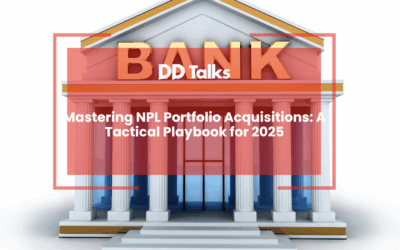Key Takeaways
- Re-performing loans represent a growing opportunity in European markets, offering higher yields than traditional performing loans with lower risk profiles than non-performing exposures.
- RPLs occupy a unique position in the credit spectrum with distinct regulatory treatment, requiring specialized servicing approaches that balance collection efficiency with borrower support.
- The non-QM lending sector has evolved to provide crucial financing channels for previously distressed borrowers who have demonstrated financial recovery.
- Successful RPL investment strategies combine granular loan-level analysis, diversified portfolio construction, and strategic exit planning tailored to these unique assets.
- RPL securitization offers attractive yield enhancement with structural protections specifically designed to address the risk factors associated with previously delinquent collateral.
- Effective risk management for RPL portfolios requires sophisticated modeling that incorporates payment behavior, servicing oversight, and regulatory compliance across jurisdictions.
- Technological innovations including advanced analytics, AI, and blockchain are transforming RPL portfolio management, improving both operational efficiency and risk assessment capabilities.
- The future RPL market will be characterized by increased institutionalization, regulatory harmonization, ESG integration, and greater standardization of securitization practices.
The Re-Performing Loan Opportunity: Unlocking Value in 2025
The European banking landscape is witnessing a significant transformation in the re-performing loan (RPL) market. As we approach 2025, financial institutions and investors are increasingly recognising the untapped potential within previously distressed debt portfolios. This evolution presents a unique opportunity for stakeholders to capitalise on assets that have transitioned from non-performing status to making consistent payments again. With regulatory changes, technological advancements, and shifting market dynamics, the RPL sector is poised for substantial growth across Europe. This comprehensive analysis explores the multifaceted aspects of re-performing loans, examining investment strategies, risk management approaches, and future market trends that will define this asset class in the coming years.
Table of Contents
- Understanding Re-Performing Loans in Today’s Market
- How RPLs Differ from Non-Performing and Performing Loans
- The Evolution of Non-QM Lending for Previously Distressed Borrowers
- Key Investment Strategies for Re-Performing Loan Portfolios
- What Makes RPL Securitization Attractive to Investors?
- Managing Risks in Re-Performing Loan Acquisitions
- Technology Innovations Transforming RPL Portfolio Management
- Future Outlook: RPL Market Trends for 2025 and Beyond
Understanding Re-Performing Loans in Today’s Market
Re-performing loans represent a distinct category of debt that has recovered from delinquency and returned to a payment schedule. In the European context, these loans typically emerge from previously non-performing exposures where borrowers have demonstrated renewed ability and willingness to meet their obligations. The post-pandemic economic landscape has created a fertile environment for RPLs, with many borrowers recovering financial stability after temporary hardships.
European banks currently hold significant volumes of re-performing loans, particularly in markets like Italy, Spain, and Greece, where non-performing loan ratios had previously reached concerning levels. These assets offer a compelling value proposition as they combine higher yields than traditional performing loans with substantially lower risk profiles than non-performing exposures. The European Banking Authority has noted that successful loan rehabilitation programmes have contributed to the growth of this asset class, with re-performance rates showing steady improvement since 2021.
For financial institutions, re-performing loans represent an opportunity to improve balance sheet metrics while maintaining relationships with recovering borrowers. The careful management of these portfolios requires specialised servicing approaches that balance collection efficiency with borrower support mechanisms designed to sustain long-term performance.
How RPLs Differ from Non-Performing and Performing Loans
Re-performing loans occupy a unique middle ground in the credit spectrum, distinguished by their rehabilitation history and risk profile. Unlike non-performing loans (NPLs), which are typically in default or severe delinquency, RPLs have established a track record of consistent payments following a period of distress. This crucial distinction affects valuation, servicing requirements, and investor perception.
From a regulatory perspective, European banks classify loans differently once they achieve re-performing status. While the European Central Bank maintains stringent guidelines for NPL classification, re-performing loans that demonstrate sustained payment history—usually 12 consecutive months of performance—can be reclassified, improving key regulatory ratios. This transition carries significant implications for capital requirements and provisioning.
Compared to traditional performing loans, RPLs exhibit higher yield potential but also elevated risk characteristics. The probability of re-default remains a key consideration, with historical data showing approximately 20-30% higher recidivism rates compared to loans without previous delinquency. This risk premium is reflected in pricing, with RPLs typically trading at discounts to face value, albeit significantly smaller discounts than those applied to non-performing exposures.
The servicing approach for RPLs also differs markedly, requiring more intensive monitoring and often specialised workout strategies that address the underlying factors that contributed to the initial delinquency. This specialised servicing represents both a challenge and an opportunity for investors seeking to maximise returns from these assets.
The Evolution of Non-QM Lending for Previously Distressed Borrowers
The non-qualified mortgage (non-QM) sector has emerged as a vital financing channel for borrowers with previous credit challenges, including those who have re-established payment performance after delinquency. This lending segment has evolved significantly across European markets, adapting to both regulatory frameworks and the growing recognition of credit rehabilitation patterns among previously distressed borrowers.
European lenders have developed sophisticated underwriting methodologies that look beyond traditional credit scoring models to evaluate borrowers with complex financial histories. These alternative assessment approaches consider factors such as post-delinquency payment consistency, current income stability, and improved debt-to-income ratios. The result is a more nuanced evaluation that enables access to credit for borrowers who would otherwise remain excluded from conventional financing channels.
The maturation of non-QM lending has coincided with regulatory developments that seek to balance consumer protection with credit accessibility. While maintaining prudent standards, European regulators have increasingly recognised the importance of providing pathways back to mainstream financial services for borrowers who demonstrate financial recovery. This regulatory evolution has supported the growth of specialised lending programmes tailored to the unique circumstances of previously delinquent borrowers.
For investors, the non-QM segment offers attractive yield opportunities, particularly when backed by re-performing collateral with established payment histories. Understanding re-performing loans and non-QM financing has become essential for portfolio managers seeking diversification and enhanced returns in the current low-yield environment.
Key Investment Strategies for Re-Performing Loan Portfolios
Successful investment in re-performing loan portfolios requires tailored strategies that address the unique characteristics of these assets. European investors have developed several approaches to maximise returns while managing the inherent risks associated with previously distressed debt. The most effective strategies combine rigorous due diligence, active portfolio management, and strategic exit planning.
Granular loan-level analysis forms the foundation of RPL investment, with sophisticated investors developing proprietary models to predict re-default probabilities and prepayment speeds. These models incorporate macroeconomic variables, property valuation trends, and borrower behavioural patterns to identify the most promising assets within available portfolios. European investors typically segment RPL opportunities based on factors such as seasoning (time since re-performance began), loan-to-value ratios, and borrower employment stability.
Portfolio construction strategies often involve diversification across geographic regions, property types, and re-performance vintages. This approach mitigates concentration risk while allowing investors to benefit from varying regional economic conditions across European markets. Many successful RPL investors maintain relationships with multiple servicing partners specialised in different borrower segments or regional markets.
Exit strategies for RPL portfolios include securitisation, whole loan sales to other institutional investors, and long-term hold approaches that capture the full value of the performing cash flows. The optimal strategy depends on market conditions, portfolio characteristics, and investor time horizons. Increasingly, European investors are implementing hybrid approaches that allow for flexibility as market conditions evolve.
What Makes RPL Securitization Attractive to Investors?
RPL securitisation has emerged as a compelling financial instrument in European capital markets, offering unique advantages that attract diverse investor classes. The structured nature of these securities allows for precise risk calibration, creating tranches that appeal to different risk appetites and investment mandates. This tailored approach has expanded the investor base for re-performing assets beyond traditional distressed debt specialists.
The yield enhancement potential of RPL securitisations stands as a primary attraction in the current European interest rate environment. Senior tranches of well-structured RPL securitisations typically offer 100-200 basis points of spread premium compared to similarly rated traditional mortgage-backed securities, reflecting the additional risk component while maintaining investment-grade characteristics. This yield advantage has drawn significant attention from institutional investors seeking to outperform benchmarks without assuming excessive risk.
Structural protections in European RPL securitisations have evolved significantly, incorporating features such as step-up servicing fees to incentivise performance, reserve accounts sized to historical re-default patterns, and trigger mechanisms that redirect cash flows to protect senior investors if performance deteriorates. These enhancements address the specific risk factors associated with previously delinquent collateral and provide comfort to rating agencies and investors alike.
The improving transparency and data availability for European RPL securitisations has further enhanced their appeal. Issuers now typically provide detailed loan-level information, performance histories, and stress test scenarios that enable sophisticated analysis by potential investors. This transparency has contributed to more efficient pricing and greater market liquidity for these securities.
Managing Risks in Re-Performing Loan Acquisitions
Effective risk management is paramount when acquiring re-performing loan portfolios in European markets. The multifaceted nature of these assets necessitates a comprehensive approach to identifying, quantifying, and mitigating various risk factors. Successful investors implement robust frameworks that address credit, operational, regulatory, and market risks specific to previously distressed debt.
Credit risk assessment for RPLs requires sophisticated modelling that goes beyond traditional approaches. Leading European investors employ advanced analytics that incorporate payment shock sensitivity, employment sector vulnerability, and property market correlation factors. These models typically assign higher weightings to recent payment behaviour while still accounting for the severity and recency of previous delinquencies. Stress testing these portfolios against various economic scenarios has become standard practice, with particular attention to interest rate sensitivity given the current monetary policy environment across Europe.
Operational risk management focuses heavily on servicing oversight, as the quality of loan servicing significantly impacts RPL performance. Investors increasingly implement comprehensive servicer monitoring programmes, tracking key performance indicators such as borrower contact rates, modification success, and early intervention metrics. Many sophisticated investors maintain backup servicing arrangements to mitigate transition risk if primary servicers underperform.
Regulatory risk has gained prominence as European authorities continue to evolve their approaches to consumer protection and debt collection practices. Successful RPL investors maintain dedicated compliance teams that monitor regulatory developments across jurisdictions, ensuring that servicing practices remain compliant with local requirements. This regulatory vigilance has become particularly important as countries implement varying approaches to post-pandemic debt management policies.
Technology Innovations Transforming RPL Portfolio Management
Technological advancement has revolutionised the management of re-performing loan portfolios across European markets. Digital transformation initiatives have enhanced every aspect of the RPL lifecycle, from initial due diligence through ongoing servicing and eventual disposition. These innovations have simultaneously improved operational efficiency and risk management capabilities.
Advanced data analytics platforms now enable real-time monitoring of RPL portfolio performance, with early warning systems that identify subtle indicators of potential re-default. These systems integrate traditional payment data with alternative information sources, including utility payment patterns, employment sector trends, and property market dynamics. Leading European servicers have developed proprietary algorithms that predict which borrowers may require intervention before they miss payments, allowing for proactive engagement strategies.
Artificial intelligence and machine learning applications have transformed borrower communication strategies for RPL portfolios. These technologies enable personalised outreach approaches based on borrower behavioural patterns, optimising both the timing and content of communications to maximise engagement and payment likelihood. Some advanced platforms now incorporate natural language processing to analyse customer interactions, identifying potential hardship situations that might require specialised assistance.
Blockchain technology is beginning to impact RPL documentation and verification processes, addressing historical challenges related to loan file integrity and ownership records. Several European financial institutions have piloted blockchain-based systems for maintaining immutable records of loan modifications, payment histories, and servicing rights transfers. These innovations promise to reduce disputes and streamline due diligence processes for future transactions.
Future Outlook: RPL Market Trends for 2025 and Beyond
The European re-performing loan market is poised for significant evolution through 2025 and beyond, shaped by macroeconomic factors, regulatory developments, and changing investor preferences. Several key trends are likely to define this market segment in the coming years, creating both opportunities and challenges for market participants.
Increasing institutionalisation of the RPL market represents a primary trend, with specialised investment managers developing dedicated strategies focused exclusively on this asset class. This specialisation is driving greater efficiency in pricing and operations, while also attracting new sources of capital to the sector. By 2025, we anticipate the emergence of several dominant European RPL investment platforms with vertically integrated capabilities spanning acquisition, servicing, and securitisation.
Regulatory harmonisation across European jurisdictions will likely progress, albeit gradually, creating more consistent frameworks for RPL management and collection practices. This convergence should enhance market liquidity by reducing cross-border complexity, though national differences will persist in consumer protection approaches. Forward-thinking investors are already positioning themselves to benefit from this regulatory evolution by developing flexible operational models adaptable to various jurisdictional requirements.
The integration of environmental, social, and governance (ESG) considerations into RPL investment strategies represents another emerging trend. Investors increasingly recognise the social impact dimension of responsible RPL management, which can support financial inclusion and housing stability. By 2025, we expect to see dedicated ESG-focused RPL funds that emphasise sustainable workout solutions and borrower financial health alongside traditional return metrics.
Finally, the continued maturation of the RPL securitisation market will likely lead to greater standardisation and liquidity in these instruments. As rating agencies refine their approaches to evaluating re-performing collateral and investor comfort with these securities grows, we anticipate RPL securitisations becoming a mainstream fixed income category rather than an alternative investment niche.
Frequently Asked Questions
What is a re-performing loan (RPL)?
A re-performing loan is a debt that has recovered from delinquency and returned to a consistent payment schedule. These loans have transitioned from non-performing status after borrowers demonstrated renewed ability and willingness to meet their obligations, typically maintaining payments for at least 12 consecutive months. RPLs occupy a middle ground between non-performing loans and traditional performing loans, offering higher yields than standard performing loans while carrying lower risk than non-performing exposures.
Why are re-performing loans attractive to investors in 2025?
Re-performing loans are attractive to investors in 2025 due to several factors: they offer yield enhancement (typically 100-200 basis points higher than traditional securities with similar ratings), benefit from improved regulatory frameworks, leverage advanced technology for better risk management, and provide portfolio diversification. Additionally, the maturation of RPL securitization markets has created more standardized investment vehicles, while the post-pandemic economic recovery has improved the overall performance metrics of these assets.
How do banks classify re-performing loans for regulatory purposes?
Banks typically reclassify loans from non-performing to re-performing status after a sustained period of consistent payments, usually 12 consecutive months of performance. This reclassification improves key regulatory ratios, reduces capital requirements, and decreases necessary loan loss provisions. European regulatory authorities, including the European Central Bank, maintain specific guidelines for this transition, though exact requirements may vary slightly across different European jurisdictions.
What are the main risks associated with re-performing loan investments?
The main risks of re-performing loan investments include: higher re-default probability (20-30% higher recidivism rates compared to loans without previous delinquency), servicing risk (quality of loan servicing significantly impacts performance), regulatory risk (evolving consumer protection and debt collection regulations), interest rate sensitivity, and property valuation risk. Effective management requires sophisticated analytics, robust servicing oversight, regulatory compliance monitoring, and comprehensive stress testing against various economic scenarios.
How has technology changed re-performing loan portfolio management?
Technology has transformed RPL portfolio management through advanced data analytics that provide real-time monitoring with early warning systems for potential re-defaults, artificial intelligence that personalizes borrower communications based on behavioral patterns, machine learning algorithms that optimize collection strategies, and blockchain applications that improve loan documentation integrity. These innovations have simultaneously enhanced operational efficiency, risk management capabilities, and borrower engagement strategies.
What makes RPL securitization different from traditional mortgage-backed securities?
RPL securitization differs from traditional mortgage-backed securities through enhanced structural protections (including step-up servicing fees, larger reserve accounts, and specialized trigger mechanisms), higher yield potential reflecting the additional risk component, more detailed loan-level disclosure requirements, and specialized servicing arrangements. These securities are specifically designed to address the unique risk characteristics of previously delinquent collateral while providing appropriate risk-adjusted returns to different investor classes through various tranches.
How will ESG considerations impact the RPL market by 2025?
By 2025, ESG considerations will significantly impact the RPL market through the development of dedicated ESG-focused RPL funds, greater emphasis on sustainable workout solutions that support borrower financial health, increased transparency around social impact metrics related to housing stability and financial inclusion, and the integration of environmental factors in property valuation models. Investors will increasingly recognize the social dimension of responsible RPL management, balancing traditional return metrics with positive societal outcomes in their investment strategies.




0 Comments